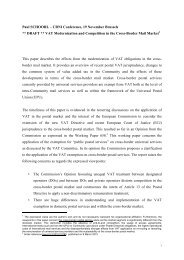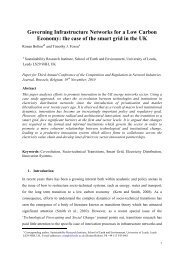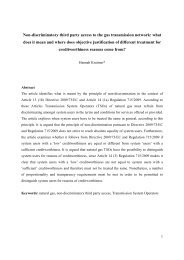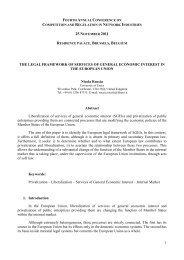Regulatory Incentives for Investments in Electricity Networks - CRNI ...
Regulatory Incentives for Investments in Electricity Networks - CRNI ...
Regulatory Incentives for Investments in Electricity Networks - CRNI ...
Create successful ePaper yourself
Turn your PDF publications into a flip-book with our unique Google optimized e-Paper software.
eta<strong>in</strong><strong>in</strong>g these ga<strong>in</strong>s. Shar<strong>in</strong>g schemes have been considered <strong>in</strong> Australia and the UK <strong>in</strong> the<br />
context of the build<strong>in</strong>g blocks approach used <strong>in</strong> these countries.<br />
The length of the efficiency carry-over reflects the implied benefit shar<strong>in</strong>g between regulated<br />
service provider and network service users. A long term carry-over mechanism provides a<br />
<strong>for</strong>ward look<strong>in</strong>g framework with<strong>in</strong> which the regulated service provider’s actual costs <strong>in</strong> future<br />
regulatory periods will provide a better <strong>in</strong>dicator of efficient cost levels. On the other hand,<br />
conta<strong>in</strong><strong>in</strong>g the carry-over not only <strong>in</strong> the follow<strong>in</strong>g (second) regulatory period but also <strong>in</strong> the<br />
subsequent (third) one would <strong>in</strong>crease complexity and delay the process of transferr<strong>in</strong>g the<br />
benefits to the f<strong>in</strong>al consumers.<br />
The carry-over mechanism should provide sufficient <strong>in</strong>centives <strong>for</strong> regulated network companies<br />
to pursue efficiency ga<strong>in</strong>s. That is, the benefit that regulated network companies reta<strong>in</strong> at the<br />
marg<strong>in</strong> should outweigh the cost of the efficiency improvement. There is no universal <strong>for</strong>mula<br />
<strong>for</strong> optimal shar<strong>in</strong>g of ga<strong>in</strong>s. The optimal relationship between ga<strong>in</strong>s reta<strong>in</strong>ed and efficiencies<br />
achieved depends on the underly<strong>in</strong>g assumptions regard<strong>in</strong>g the responsiveness of the regulated<br />
companies (<strong>in</strong> terms of cost reduction and <strong>in</strong>novation) to changes <strong>in</strong> the share of efficiency ga<strong>in</strong>s<br />
they reta<strong>in</strong>.<br />
It could be argued that the greater the share of the benefits regulated network companies are<br />
allowed to reta<strong>in</strong>, the greater their <strong>in</strong>centive to make efficiency sav<strong>in</strong>gs and, hence, the greater<br />
the extent of sav<strong>in</strong>gs to be eventually passed on to consumers. On the other hand, it is evident<br />
that the greater the share that regulated companies are allowed to reta<strong>in</strong>, the longer consumers<br />
will have to wait be<strong>for</strong>e the benefits from efficiency sav<strong>in</strong>gs are passed through to them.<br />
Furthermore, when decid<strong>in</strong>g on the amount of cost reductions to be carried-over, it is difficult <strong>for</strong><br />
the regulator to determ<strong>in</strong>e which cost reductions are a consequence of management decisions and<br />
which are w<strong>in</strong>dfall profits, result<strong>in</strong>g <strong>for</strong> example from changes <strong>in</strong> <strong>in</strong>put prices. 20<br />
20 There are a range of factors that could cause the regulated company to earn a different rate of return from that<br />
<strong>for</strong>ecast at the <strong>in</strong>itial price review. Some of those factors may be with<strong>in</strong> the control of the regulated company, and<br />
others may be external to them. In pr<strong>in</strong>ciple, there are sound reasons to treat unexpected profits differently,<br />
depend<strong>in</strong>g on their source. Some profits may result from <strong>in</strong>fluences and events external to the regulated company<br />
(i.e. w<strong>in</strong>dfall ga<strong>in</strong>s) rather than from its direct actions. It follows that they can be shared with customers at the next<br />
review without hav<strong>in</strong>g any adverse impact on the <strong>in</strong>centives of the regulated service provider to pursue efficiencies<br />
that are with<strong>in</strong> their control. Conversely, allow<strong>in</strong>g the regulated company to keep the additional profits that arise<br />
from actions under their control (i.e. controllable ga<strong>in</strong>s) <strong>for</strong> a longer period should give them a strong <strong>in</strong>centive to<br />
cont<strong>in</strong>ue mak<strong>in</strong>g such efficiency ga<strong>in</strong>s <strong>in</strong> the future. A typical example of controllable ga<strong>in</strong>s is when the regulated<br />
company may have reduced actual expenditure below that <strong>for</strong>ecast via more efficient use of labour, ma<strong>in</strong>tenance and<br />
capital expenditure, and/or by <strong>in</strong>troduc<strong>in</strong>g more efficient systems <strong>for</strong> operations.<br />
Additional profits may result from factors that are not with<strong>in</strong> the control of the regulated company. For example,<br />
general economic growth may have been greater than <strong>for</strong>ecast, or market <strong>in</strong>terest rates may have fallen below those<br />
underly<strong>in</strong>g the orig<strong>in</strong>al <strong>for</strong>ecasts, and this may have <strong>in</strong>creased revenues or reduced f<strong>in</strong>anc<strong>in</strong>g costs. While the<br />
pr<strong>in</strong>ciple of differentiat<strong>in</strong>g between potential sources of <strong>in</strong>creased profitability appears sound, it may be difficult to<br />
dist<strong>in</strong>guish with any precision those different sources <strong>in</strong> practice. A significant degree of regulatory judgment will<br />
be required <strong>in</strong> order to dist<strong>in</strong>guish the different reasons <strong>for</strong> any gap between the returns <strong>in</strong>corporated at the <strong>in</strong>itial<br />
revenue sett<strong>in</strong>g and those now be<strong>in</strong>g achieved by the regulated service provider.<br />
16







